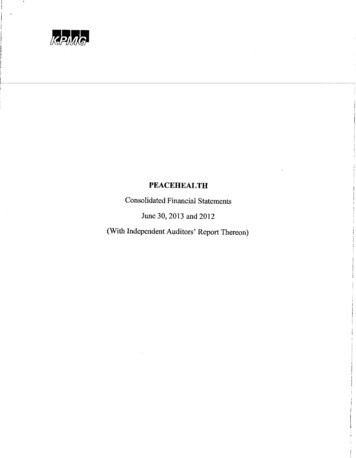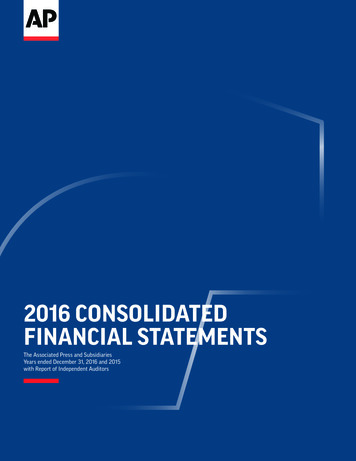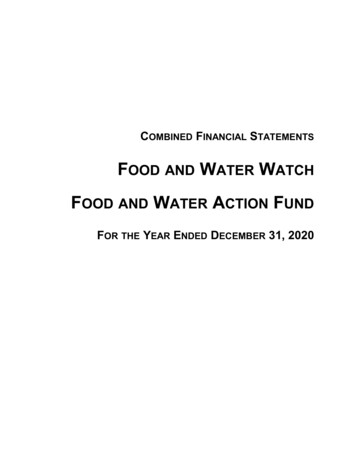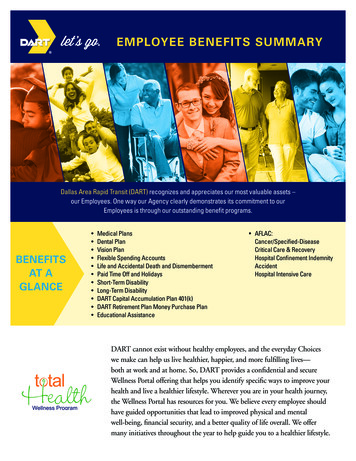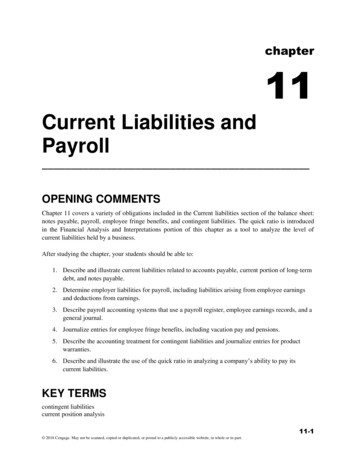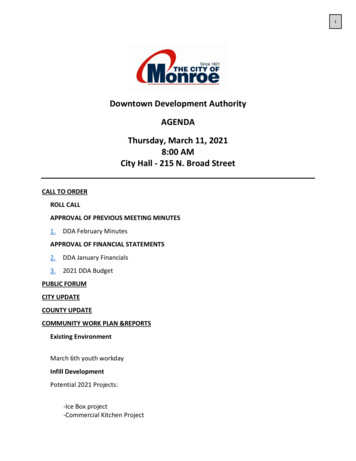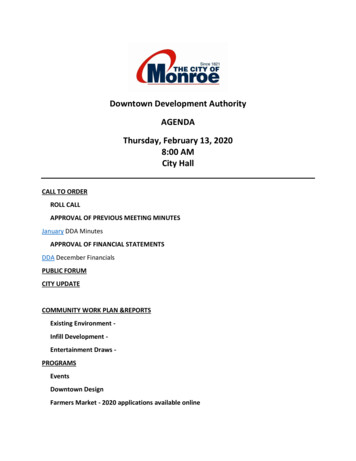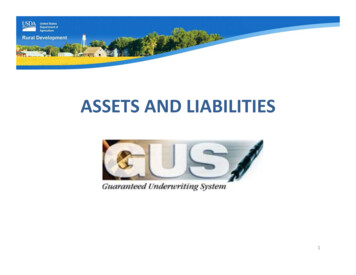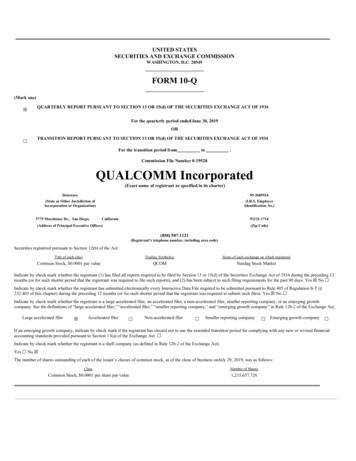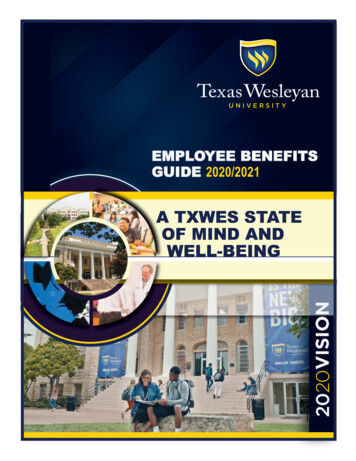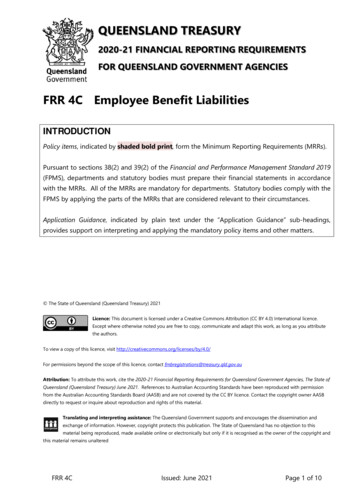
Transcription
QUEENSLAND TREASURY2020-21 FINANCIAL REPORTING REQUIREMENTSFOR QUEENSLAND GOVERNMENT AGENCIESFRR 4C Employee Benefit LiabilitiesINTRODUCTIONPolicy items, indicated by shaded bold print, form the Minimum Reporting Requirements (MRRs).Pursuant to sections 38(2) and 39(2) of the Financial and Performance Management Standard 2019(FPMS), departments and statutory bodies must prepare their financial statements in accordancewith the MRRs. All of the MRRs are mandatory for departments. Statutory bodies comply with theFPMS by applying the parts of the MRRs that are considered relevant to their circumstances.Application Guidance, indicated by plain text under the “Application Guidance” sub-headings,provides support on interpreting and applying the mandatory policy items and other matters. The State of Queensland (Queensland Treasury) 2021Licence: This document is licensed under a Creative Commons Attribution (CC BY 4.0) International licence.Except where otherwise noted you are free to copy, communicate and adapt this work, as long as you attributethe authors.To view a copy of this licence, visit http://creativecommons.org/licenses/by/4.0/For permissions beyond the scope of this licence, contact fmbregistrations@treasury.qld.gov.auAttribution: To attribute this work, cite the 2020-21 Financial Reporting Requirements for Queensland Government Agencies, The State ofQueensland (Queensland Treasury) June 2021. References to Australian Accounting Standards have been reproduced with permissionfrom the Australian Accounting Standards Board (AASB) and are not covered by the CC BY licence. Contact the copyright owner AASBdirectly to request or inquire about reproduction and rights of this material.Translating and interpreting assistance: The Queensland Government supports and encourages the dissemination andexchange of information. However, copyright protects this publication. The State of Queensland has no objection to thismaterial being reproduced, made available online or electronically but only if it is recognised as the owner of the copyright andthis material remains unalteredFRR 4CIssued: June 2021Page 1 of 10
FRR 4CEmployee Benefit LiabilitiesTABLE OF CONTENTS4C.1RECOGNITION AND TYPES OF BENEFITS .24C.2CURRENT / NON-CURRENT SPLIT .94C.1RECOGNITION AND TYPES OF BENEFITSREFERENCES- AASB 119 Employee BenefitsPOLICY An employee benefit liability for accumulated and unused Time Off In Lieu(TOIL) and Rostered Days Off (RDO) leave at reporting date must be recognisedwhen: the amount is material when measured on an agency basis; and if it is probable that the outstanding TOIL leave will be used byemployees before leaving the agency, or if TOIL is paid out ontermination. AASB 119 does not specifically state that elected members are deemed to beemployees. However, in the interests of public information, where employeebenefits for elected members are material, they must be disclosed as a liabilityin the financial statements of the relevant agency.APPLICATION GUIDANCEOverall Criteria for Recognition as a LiabilityFor an employee benefit liability to be recognised, it must be probable that settlement willbe required and that the liability can be measured reliably. All entitlements that vest in anemployee satisfy the definitions of expenses and liabilities and should be measured andreported. Non-vesting employee benefits may satisfy the definition of expenses orliabilities but they may not meet the recognition criteria as it may not be possible toreliably measure the liability or expense.FRR 4CIssued: June 2021Page 2 of 10
FRR 4CEmployee Benefit LiabilitiesShort-term employee benefits (liabilities expected to be wholly settled within 12 months)are to be measured at their nominal value (i.e. undiscounted).Employee benefits that meet the definition for other long-term employee benefits are tobe measured according to most of the requirements for defined benefit plans under AASB119 except for the requirement for remeasurements of the net defined benefit liability(asset) recognised in other comprehensive income.Sick LeaveA present obligation in respect of employees’ accumulated sick leave entitlements arisesonly when it is probable that the sick leave to be taken by employees in any futurereporting period will be greater than the entitlements that will be accumulated in thatfuture period.Where experience indicates that, on average, sick leave taken each reporting period is lessthan or equal to the entitlement accruing in that period and this trend is expected to recurin future periods, it is unlikely that existing accumulated entitlements will be used byemployees. Accordingly, no liability for unused sick leave entitlements should berecognised.As an example, measured on an agency basis, the average period of sick leave taken peremployee over the last three reporting periods is five days per year. The averageentitlement to sick leave accruing per employee over the same period is 10 days per year.There is no reason to expect that the number of days taken in sick leave will exceed the 10days per year accruing in future reporting periods and accordingly, no liability should berecognised.Annual LeaveAgencies that are members of the Annual Leave Central Scheme (ALCS)Agencies that participate in the ALCS do not recognise a liability for annual leaveentitlements in their financial statements since the employer obligation is held by theState. Therefore, generally only the annual leave levy expenses are recognised as employeeexpenses.As the agency itself makes the annual leave payments to employees, it will need to claimback these amounts from the ALCS as a reimbursement. Amounts claimed from thescheme but not actually recouped at reporting date are a receivable for the agency.FRR 4CIssued: June 2021Page 3 of 10
FRR 4CEmployee Benefit LiabilitiesALCS policy specifies the on-costs that are to be included in the ALCS levy calculations.On-cost rates are determined by shared service providers (e.g. Queensland SharedServices) in consultation with the agencies that they service and are reviewed on an annualbasis.The guidelines for the ALCS set out the arrangements for dealing with transfers ofemployees which depend on whether the transferee agency is a member of the scheme.These guidelines are available at: cs/annual-leave-guidelines/index.shtmlGenerally, the only accounting consequences for member agencies under the ALCS arewhere cash payments need to be made to the scheme for a higher remuneration rateapplicable after commencement of the employee in the transferee agency.Agencies that are not members of the ALCSEmployees’ annual leave entitlements at reporting date are to be recognised as accruedemployee benefit liabilities.Where payments such as leave loading are payable under an award, they also should beincluded in the calculation of the related employee benefit liability, where they are notpaid out annually.All directly associated on-costs (e.g. employer superannuation contributions, payroll tax(where applicable) and workers’ compensation insurance) should be included wherematerial. For financial reporting purposes agencies may split the employee benefit liabilityamount between relevant line items such as payroll tax (where applicable) and worker’scompensation.Where the agency’s entire liability for annual leave is not expected to be wholly settledwithin 12 months of the end of the reporting period, it is to be treated as per other longterm employee benefits. On that basis, the liability is to be accounted for, and disclosed,consistent with defined benefit plans (refer to paragraphs 55 – 152 of AASB 119).Where an agency is not a member of the ALCS, the main accounting consequences foremployee transfers is that, to the extent that cash is not transferred, income or expensesare to be recognised in respect of leave entitlements transferred to another agency oracquired from another agency respectively.FRR 4CIssued: June 2021Page 4 of 10
FRR 4CEmployee Benefit LiabilitiesLong Service LeaveAgencies that are members of the Long Service Leave Central Scheme (LSLCS)Agencies that participate in the LSLCS do not recognise a liability for long service leaveentitlements in their financial statements as the employer obligation is held by the State.Therefore, generally only the long service leave levy expenses are recognised as employeeexpenses.As the agency itself makes the long service leave payments to employees, it will need toclaim back these amounts from the LSLCS as a reimbursement. Amounts claimed from thescheme, but not actually recouped at reporting date, are a receivable for the agency.The guidelines for the LSLCS set out the arrangements for dealing with transfers ofemployees, which depend on whether the transferee agency is a member of the scheme.These guidelines are available erally, the only accounting consequences for member agencies under the LSLCS arewhere a transferred employee previously earned long service leave entitlements at anentity that is not party to the reciprocal leave recognition arrangements outlined in theQueensland Public Service Award and the agency chooses to recognise those long serviceleave entitlements on commencement. In this situation, a cash payment would be madeto the LSLCS.Agencies that are not members of the LSLCSGenerally, agencies which are not part of the LSLCS manage their own leave balances. Thefollowing entitlement categories of long service leave are common:(a)An ‘unconditional’ legal entitlement to payment arises after a qualifying period ofservice (e.g. 10 years). Accumulation of long service leave entitlement continuesafter this point until the leave is taken.(b)A ‘conditional’ entitlement exists in certain circumstances (e.g. death, retrenchment,or early retirement under some awards) and a legal entitlement to pro rata paymentin lieu of long service leave arises (sometimes only after a qualifying period ofservice).FRR 4CIssued: June 2021Page 5 of 10
FRR 4C(c)Employee Benefit LiabilitiesUnder a ‘pre-conditional’ entitlement, no legal entitlement to any payment or leaveexists before the accumulation of the period of service necessary to qualify for theentitlement described in (a) or (b) above.In the Queensland public sector there are generally only two categories of long serviceleave, being an unconditional entitlement and pre-conditional entitlement. However, insome special circumstances (as set out in Public Service Commission directives) a pro-ratapayment may be made to a Queensland public sector employee.Agencies that are not members of the LSLCS should generally treat their long service leaveobligations as other long-term employee benefits. On that basis, they are to be accountedfor, and disclosed, consistent with defined benefit plans (refer to paragraphs 55 – 152 ofAASB 119).Where an agency is not a member of the LSLCS, the main accounting consequences foremployee transfers is that, to the extent that cash is not transferred, income or expensesare to be recognised in respect of leave entitlements transferred to another agency oracquired from another agency respectively.SuperannuationQueensland Treasury’s distinction between the two types of superannuation plans is asfollows: Defined contribution plans – the State’s obligation is limited to the amount that itagrees to contribute to the plan. As a result, superannuation entitlement risk (thatbenefits will be less than expected) and investment risk (that returns on assetsinvested will be insufficient to ultimately meet expected benefits) fall on theemployee. Defined benefit plans – the State’s obligation is to provide the agreed benefits tocurrent and former employees, resulting in superannuation entitlement risk (thatbenefits will cost more than expected) and investment risk falling on the State. Ifsuperannuation entitlements are greater than expected or investment returns areworse than expected, the State will cover any shortfall.FRR 4CIssued: June 2021Page 6 of 10
FRR 4CEmployee Benefit LiabilitiesDefined Contribution Plans – No actuarial assumptionsThe accounting and recognition for defined contribution plans is straightforward as theState’s obligation for each period is limited to the amounts to be contributed for thatperiod. No actuarial assumptions are required to measure the obligation or the expense,and no actuarial gain or loss arises.As an employee renders service, agencies must recognise the contributions payable to thesuperannuation plan: as a liability (accrued expense) after deducting any contributions already paid. Ifthe contributions already paid exceeds the contributions due, an agency shallrecognise that excess as an asset (prepaid expense) to the extent that theprepayment will lead to a reduction in future payments or a cash refund; and as an expense, unless an accounting standard requires or permits the inclusion ofthe contribution in the cost of an asset e.g. capitalised into the cost of a noncurrent asset under AASB 116 Property, Plant and Equipment.AASB 119 contains the recognition, measurement and disclosure requirements for definedcontribution plans.Defined Benefit Plans (Agencies contributing to QSuper)For agencies that contribute to the central QSuper scheme, the employer liability is held bythe State (consistent with the ALCS and LSLCS). Hence, no liability for superannuationbenefits should be recognised in such agencies’ financial statements, except forcontributions due and unpaid at balance date.Defined Benefit Plans (Agencies not contributing to QSuper)The accounting and recognition for defined benefit plans is more complex. The ultimatecost to the employer of a defined benefit plan may be influenced by many variables suchas final salaries, employee turnover, mortality and the investment earnings on the planassets.In order to measure the obligation and the related current service cost it is necessary to: determine the deficit or surplus - which involves using a particular actuarialtechnique to estimate the cost of the employee benefits earned by employees,discounting that benefit in order to determine the present value of the employerFRR 4CIssued: June 2021Page 7 of 10
FRR 4CEmployee Benefit Liabilitiesobligation and current service cost, and deducting the fair value of plan assets fromthe present value of the employer obligation; determine the amount of the net defined benefit liability (asset); determine various amounts to be recognised in the operating result; and determine the re-measurements of the net defined benefit liability (asset) to berecognised in other comprehensive income.Paragraphs 55-152 of AASB 119 contain the detailed requirements regarding theaccounting for, and disclosure of, defined benefit plans.It will be necessary for agencies to engage an actuary to determine an agency’ssuperannuation liability. Agencies should refer to AASB 119 for details about calculationand disclosure requirements. Interpretation 14 AASB 119 – The Limit on a Defined BenefitAsset, Minimum Funding Requirements and their Interaction should also be referred to forguidance on: how to assess the limit in AASB 119 on the amount of a surplus that can berecognised as an asset by an employer sponsor to a defined benefit plan; how a defined benefit surplus/deficiency recognised by an employer sponsor maybe impacted by a statutory or contractual minimum funding requirement; when refunds or reductions in future contributions should be regarded as availableunder AASB 119; how a minimum funding requirement might affect availability of reductions infuture contributions; and when a minimum funding requirement might give rise to a liability.Other Post-Employment BenefitsThese benefits should not apply to most agencies. When they are payable, a liability mustbe recognised: progressively over the reporting periods up to the time when the benefits becomevested after a specified qualifying period; andFRR 4CIssued: June 2021Page 8 of 10
FRR 4C Employee Benefit Liabilitiesin the reporting period an employee is appointed to a specific position where thebenefits vest at the time of appointment.Examples of post-employment benefits include the provision of free or subsidised non-monetary benefits after the completion of employment, such as air or train travel, officeaccommodation, administrative support and the use of a motor vehicle.The measurement of a post-employment benefit liability should take into account theprobability that some employees will not attain the requisite years of service entitling themto part or all of the benefits.Termination BenefitsThere may be uncertainty regarding the agency’s plans regarding terminations or numberof employees who will accept an offer of termination benefits. When this uncertaintyexists, a liability should not be recognised. Instead, a contingent liability should bedisclosed, unless the possibility of termination benefits resulting is remote, in which case,there should be no disclosure.Reference should be made to paragraphs 159-170 of AASB 119 for the requirements forthe recognition and measurement of termination benefit liabilities.4C.2CURRENT / NON-CURRENT SPLITREFERENCES- AASB 101 Presentation of Financial Statements- AASB 119 Employee BenefitsAPPLICATION GUIDANCEDistinguishing between current and non-current employee liabilitiesFor presentation and disclosure purposes under AASB 101, agencies must distinguishcurrent employee benefit liabilities from non-current employee benefit liabilities – thisapplies to all employee benefits, including performance payments and terminationbenefits.FRR 4CIssued: June 2021Page 9 of 10
FRR 4CEmployee Benefit LiabilitiesMeasurement under AASB 119 not affected by AASB 101 presentationThe fact that a class of employee benefit liability (other than short-term employeebenefits) may be split into current and non-current components under AASB 101 does notaffect how the entire class of benefit is to be measured under AASB 119 (e.g. as an ‘otherlong-term employee benefit’). Agencies should therefore ensure employee benefitliabilities are correctly classified and measured under AASB 119 principles beforedetermining the current / non-current split under AASB 101.AASB 101 specifies that a liability is classified as current where: there is no unconditional right to defer settlement of a liability for at least twelvemonths after the end of the reporting period; or the liability is due to be settled within twelve months after the end of the reportingperiod.Consequently: any class of employee benefit that meets the definition of “short-term employeebenefits” in AASB 119 is a current liability under AASB 101; and any class of employee benefit under AASB 119 (other than short-term employeebenefits) will be a current liability where either of the two AASB 101 conditions(refer above) are met. (For example, annual leave liability obligations outside theALCS measured as “other long term benefits” as discussed in the guidance to FRR4C.1.)FRR 4CIssued: June 2021Page 10 of 10
FRR 4C Employee Benefit Liabilities . FRR 4C Issued: June 2021 Page 3 of 10 . Short-term employee benefits (liabilities expected to be wholly settled within 12 months) are to be measured at their nominal value (i.e. undiscounted). Employee benefits that meet the definition for other long-term employee benefits are to
